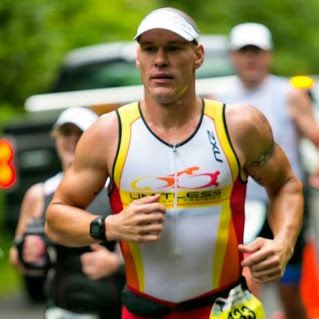
NASCAR pit crew athlete Blake Haugland
When NASCAR driver Jimmie Johnson asked his pit crew to do a sprint triathlon with him, one of the guys thought Blake Haugland, 33, professional pit crew athlete for Joe Gibbs Racing, might be interested.
“What’s a triathlon?" asked Blake, who finished the event and was immediately hooked.
He bought a tri bike the week after that first race and raced seven more times that year. Since 2013, Blake’s completed four Ironman triathlon events and races 12 or 13 times a year. And he’s a USA Triathlon and USA Cycling certified coach.
“Funny how things work out,” Blake told me when I asked him about his training and coaching.
Here’s an excerpt of our conversation.
Carolee Belkin Walker: Tell me about your work with NASCAR, is it seasonal?
Blake Haugland: I pit for Joe Gibbs Racing on the 20 Car for Matt Kenseth as a rear tire carrier. We’re based outside Charlottesville, North Carolina. The race season begins in February, and our last race is the weekend before Thanksgiving. But we work year round.
We have two or three weekends off during the season, doing about 38 races a year. During the off season we’re training for the next season and developing new equipment, practicing, and working out.
CBW: How long have you been involved in this profession?
BH: I grew up racing and driving. I wrestled in college in Iowa for a year and moved to North Carolina when I was 19 and started doing this.
It’s all I’ve ever done.
CBW: Were you also a runner?
BH: I’m not built as a fast runner. But I ran cross-country to prepare for wrestling season. I was competitive but didn’t stand out.
I never ran for competition after high school until I found triathlon. And that obviously sparked me to run and try to figure out how to enjoy it. I started doing open running races, 5Ks, 10Ks, and half marathons. Now I run about 30 miles a week.
CBW: How do you train when you’re in season? Do you swim, bike, and run? How does it work?
BH: I train year round. I’m fortunate with my job that I’m only required to go to our shop to practice, train, and watch film three days a week. When I go to the race track I travel on Saturday or Sunday to the race, on the day of the race, pit the car, and then we jump on our plane and fly back home when the race is over.
But being a father and a husband is a full time job, too. So I’ve got to schedule and juggle my workouts in order to make it work.
I’m getting up at 4 or 5 in the morning to go to the pool and then in the afternoon when my youngest is napping or when the kids are at school I’ll try to get a run in or a ride. On Friday or Saturday when I’ve got to do a long run or a long ride my family understands that dad’s gonna be gone for five or six hours. I have one day a week I dedicate to training.
CBW: That’s a pretty significant commitment. What are the benefits in terms of your NASCAR work?
BH: We’re expected to change four tires and fill a car up with gas in 10 seconds.
Before I started running I was pitting race cars but even though I was younger and should have been able to feel better, doing 8 or 10 or 12 pit stops in a race, was really hard on me. I’m carrying an 80-pound tire in my hands while I’m doing all of this.
What I noticed is when I started training for triathlons and running my body as a whole got stronger. My auxiliary muscles and my tendons and ligaments got so much stronger from training that I could go do 12 pit stops wearing a fire suit in 100-degree weather and it was business as usual. It’s no big deal compared to coming off a bike ride for 70 miles and then running 10 miles after that.
That type of fatigue prepared me for this job so much more.
Now I’ll do a half-marathon on Saturday, rest in the afternoon, and get on a plane on Sunday and pit a race.
If I sit on the couch all day and get on an airplane to go to the track my hamstrings feel tight, and I feel lethargic.
CBW: Do you worry about getting injured?
BH: The opposite. Doing speed work and fartlek running and mile repeats at the track have not just made me faster. My fast twitch muscle fibers are stronger. This is important because doing a lot of directional changing during a pit stop it’s easy to pull muscles. Triathlon training has helped keep me from getting injured.
CBW: Do you listen to anything when you train?
BH: When I went to my first triathlon and read in the rules that you couldn’t listen to an iPod, I was shocked. “You gotta be kidding me!” I thought. “How am I gonna do this?”
Now I train like I have to race and prepare myself mentally to know I’ve gotta run a marathon and ride 110 miles without listening to anything but my feet and wheels hitting the ground.
When I’m a few months out from a race, I’ll listen to music. Classic rock and newer stuff, or ‘90s rap. I really enjoy it.
CBW: You’re also doing triathlete coaching, right?
BH: Yes. As a USAT/USAC certified coach for D3 Multisport I have email and phone sessions with each of my athletes. Some coaches travel with their athletes, but I’m not able to do that because of my schedule.
I particularly like working with newer athletes or people who may not be the superstar age-group winners. Seeing other people succeed is really satisfying for me.
CBW: How do you manage your nutrition?
BH: I eat all the food groups and stay away from bad sugars and processed foods.
CBW: How does that work at the race track?
BH: Hahaha. It’s true there aren’t a lot of people in the racing world who eat that way. The truck drivers who drive the race cars and big haulers to the race track are also responsible for buying the groceries. They’re mobile command centers with their own kitchens and grills.
Our trainer makes sure there’s fresh fruit on the haulers, and our coach and athletic directors make sure there’s someone making grilled chicken. We try to be consistent with our diet. That’s the main thing.
But it’s caught on that, hey, being healthy and strong and eating well cross over to make us better athletes and drivers.
Read Carolee Belkin Walker’s Running Conversation with Jesse Kongos here.
#nascar #exercise #healthyliving #running #ironman #ironmantriathlon
